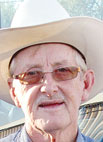
Jim McDonald has been farming long enough to know pretty much what it will cost to raise a calf to a desired weight.
So when he has an opportunity to sell for a profit, he’s going to take it.
Even if it will be months before that calf leaves his Jasper County farm near Wentworth, Mo.
For the past three years, Jim has participated in a video sale program at Joplin Regional Stockyards, offering specified lots of heifers to feedlots where they will be finished out – after Jim has given them a solid start.
“I buy about 140 heifers a year to feed out,” Jim said. “I buy them at about 450 pounds and raise them to about 750 to 800 pounds.”
Jim buys the cattle at the Joplin auction and trucks them home. A video of the heifers is made on the farm and aired to potential buyers after the stockyards’ regular Monday feeder stock sale. Videos are accompanied by a description of the lot, the number of animals to be sold, buying weights, origin, vaccination and health history and breed information. Most buyers attend the sale at the auction barn, but the videos also may be viewed and purchases made via the Internet.
A seller may withdraw from the auction if he feels prices are not high enough, but when he accepts a bid, the price for those calves are locked in – for both the seller and buyer – no matter what dips, dives or upturns the market takes before they are delivered.
While he knows he may miss some profit if the market rockets upward, Jim knows, on the other hand, that he doesn’t have to worry that the market might plunge just as he’s ready to sell.
“I like the idea of having a guaranteed price,” Jim said.
Once a contract is signed, the seller retains calves on his pastures until they reach the weight desired by the feedlot.
When the cattle arrive at Jim’s farm – or sometimes before they leave the stockyards – they get a full round of vaccinations. After that, Jim makes sure they remain healthy by checking them daily, feeding a little grain and ensuring they have plenty of good pasture to graze. He established an intensive grazing system on his 425-acre place several years back, and is pleased with its success, due in part to his dedication in keeping paddocks and grass growing in top form.
He consistently adds Red Clover to pastures, and after this summer’s drought put hay in short supply, he used no till to add Rye to 70 acres of Fescue to provide more grass for winter grazing.
This year, he began treating pastures with applications of sea minerals, which include trace elements other than nitrogen, phosphorus and potassium, the minerals used most often by American farmers to maintain grasslands. Because they contain more than the three basics, sea minerals are said to improve the soil, enhance plant growth and increase the nutritional value of the grass.
Jim also stockpiles grass for the cold months by closing some pastures to grazing once summer is over and fall growth begins.
“I lock the cows out and let the grass grow,” he said. “I save it for winter pasture.”
Jim takes good care of his grass because, after all, it is the grass that allows him to operate as a forward-contract supplier for feedlots.
“You just have to be able to put the pounds on cheaper,” Jim said, and you do that by putting animals on pasture rather than feeding grain, a luxury feedlots don’t have.
However, the advantages of the program are not all his, Jim pointed out.
“The buyers are well satisfied with the animals they get,” he said. “They know they all have had their shots, have been fed some grain and are ready for the feedlot.”
The feedlot saves money on grain because the calves are munching on Jim’s pastures.
“It’s less maintenance for them, and they know they’re getting good, healthy animals,” Jim said.
In fact, Jim is proud of the reputation his animals have gained at the local stockyards.
Jim has cut his own herd back since he began growing heifers for the feedlots, but he still maintains about 60 head in his cow/calf herd. He raises his own replacement heifers from the mostly Angus cow herd, and has a SimAngus herd bull.
“I pay a lot of attention to genetics,” Jim said. “I go for calving ease – you have to if you raise your own heifers. I like a low birth weight calf.”
Jim raises about 55 calves per year with both spring and fall calving. Calves are sold at about 650 to 700 pounds.
Maintaining his own herd – and years of experience as a cattleman – continually remind Jim that many factors between the auction barn and a loaded trailer on its way to a buyer can affect a producer’s profit margin.
And that’s why he’s perfectly happy to fill a gap between the auction and the feedlot.






